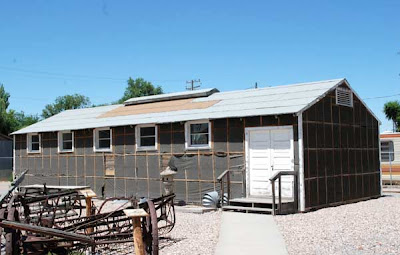The Great Basin Museum in Delta, Utah, is currently home to an exhibit about the Topaz Relocation Center (internment camp) that existed in Utah during World War II. It was built in 1942, and at its peak, housed over 8,300 Japanese-Americans. Most of the people at Topaz came from the San Francisco area of California.
Barracks from the Topaz site
Residents were housed in small barracks like this one. They were not well-built, and were cold in winter and hot in the summer. Temperatures ranged from highs of 106 degrees in summer, to lows of 30 degrees in winter. The Japanese-American residents built furniture, and organized a society here with as much normalcy as they could. They formed sports teams, musical groups, schools, and Girl Scout and Boy Scout troops. Basically, this unfairly displaced group of people made the best of a horrible situation.
Inside the barracks
The barracks were sparsely furnished. The only furniture issued to residents were bunks and a pot-bellied stove. Anything else they wanted, they had to make themselves. Piecing together scraps, internees built tables, chairs, and other things to make life more comfortable.
Antenna made by Topaz residents
The internees were not allowed much contact with the outside world. Things like radios, cameras, and even field glasses were forbidden. However, clever and enterprising internees made this antenna to receive radio broadcasts from outside their camp. There is a photo of the antenna mounted on the barracks wall in the museum.
Antenna on the barracks wall - photo
Sign at the museum
This sign is a profound reminder of the realities of this chapter in American history. So many Americans were rounded up and forced to leave their homes and belongings. Then they were asked to pledge their loyalty to America and to sign away all allegiance to the emperor of Japan. This put many of them in a tough situation. Recent immigrants were concerned that if America, their adopted country, failed them, they would have nowhere to go. Others who were born and raised in America (often not even speaking Japanese) resented having to declare loyalty to a country where they were already rightfully citizens.
Drawing of the layout of Topaz
Nothing remains at the original Topaz camp site except some foundations. After the war, buildings were sold off to local residents. My husband's family owns one of the buildings on the family farm. Many farmers took buildings to use on their farms as tool sheds, etc. If you want to see what the barracks were like and get a taste of life at Topaz, visit the Great Basin Museum in Delta. A Topaz Museum is planned and will hopefully be built one day, but for now, the Great Basin Museum provides housing for these historical artifacts.
Items recovered from the Topaz site
Many items have been excavated from the Topaz camp area and are on display at the museum. They are reminders of a people forced into harsh conditions who still tried to maintain gentility and culture in their lives.
Document at the Great Basin Museum
A great way to learn more about the plight of our fellow-citizens of Japanese heritage during World War II is to pick up a good book. Here are some recommendations!
Hotel on the Corner of Bitter and Sweet (fiction, set in Washington)
The Magic of Ordinary Days (fiction, set in Colorado)
Journey to Topaz (fiction)
The Children of Topaz (non-fiction, based on a class diary)
If you go: the Great Basin Museum is located at 328 W. 100 N. in Delta, Utah.
Phone number: 435-864-5013
Hours: Monday through Friday 10 -4
Saturdays, 1 - 4. The museum is closed on most major holidays.








No comments:
Post a Comment